The electrically-driven heavy-duty aerial work platforms market is projected to increase from USD 2,962.1 million in 2025 to USD 4,556.2 million by 2035, reflecting a consistent CAGR of 4.4%. Growth is being driven by a shift toward electrically-powered systems that reduce operational costs, enhance energy efficiency, and comply with evolving emission regulations across industrial and construction sectors. Year-on-year spikes in demand have been correlated with policy incentives promoting low-emission equipment, rising labor safety standards, and increased adoption of electrically-driven machinery in urban infrastructure projects.
Manufacturers are focusing on improving platform reliability, battery life, and load capacity, which directly influences market expansion. The rising preference for electrically-operated aerial platforms in environments where diesel or hydraulic alternatives are restricted is further fueling adoption. These trends highlight the market’s response to operational efficiency requirements and regulatory frameworks, positioning electrically-driven platforms as a preferred choice for heavy-duty vertical access applications.
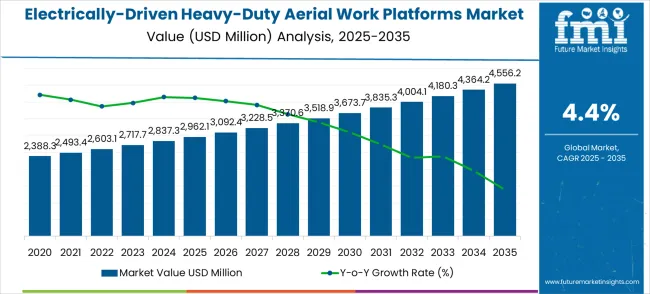
Market dynamics indicate that end-user adoption patterns are influenced by both operational cost considerations and compliance with stricter safety and environmental policies. The integration of electrically-driven heavy-duty aerial work platforms in industrial fleets is being driven by efforts to minimize maintenance interruptions and reduce energy consumption while maintaining load handling efficiency. Demand is further reinforced by construction, maintenance, and warehousing sectors where noise reduction and emission-free operation are increasingly prioritized.
Equipment providers are expanding service networks and enhancing battery performance to meet market expectations. Consequently, growth is being supported by the alignment of product capabilities with sector-specific regulatory standards and operational efficiency objectives. The electrically-driven heavy-duty aerial work platforms market is expected to sustain steady year-on-year growth, reinforcing its strategic role in modern industrial and construction operations throughout the 2025–2035 forecast period.
| Metric | Value |
|---|---|
| Estimated Value in (2025E) | USD 2,962.1 million |
| Forecast Value in (2035F) | USD 4,556.2 million |
| Forecast CAGR (2025 to 2035) | 4.4% |
The electrically-driven heavy-duty aerial work platforms market has been positioned as a strategic segment across multiple industrial and construction-related domains, capturing roughly 6.7% of the aerial work platforms market, 7.5% of the construction equipment market, 5.8% of the industrial lifting equipment market, 4.9% of the material handling equipment market, and 3.6% of the electric machinery market. Combined, the market represents an aggregated share of approximately 28.5% across these parent industries. This illustrates how electrically-driven platforms are increasingly preferred for heavy-duty lifting and access tasks, offering controlled operation, reduced manual intervention, and enhanced safety. Their adoption has been widely acknowledged by contractors, industrial operators, and infrastructure developers, marking the market as an important contributor to modern lifting and access solutions.
Market expansion is being supported by the increasing global demand for sustainable construction equipment and the corresponding shift toward electrically-driven aerial work platforms that can provide superior environmental performance while meeting operational requirements for heavy-duty lifting and positioning capabilities. Modern construction companies and industrial maintenance specialists are increasingly focused on incorporating electric aerial platforms to enhance project sustainability while satisfying demands for emission-free operation technologies and cost-effective lifting equipment. Electrically-driven aerial work platforms' proven ability to deliver superior environmental performance, operational flexibility, and cost-effective operation makes them essential equipment for indoor construction operations and environmentally sensitive project applications.
The growing emphasis on environmental compliance and operational cost optimization approaches is driving demand for high-quality electrically-driven aerial work platform products that can support distinctive construction experiences and comprehensive lifting control across construction and building, equipment maintenance, and warehousing categories. Equipment manufacturer preference for systems that combine lifting excellence with environmental performance is creating opportunities for innovative electric implementations in both construction and industrial maintenance applications. The rising influence of green building standards and sustainable construction ecosystems is also contributing to increased adoption of premium electrically-driven aerial work platform products that can provide authentic operational integration characteristics.
The electrically-driven heavy-duty aerial work platforms market represents a rapidly emerging construction equipment opportunity at the intersection of sustainable technology, vertical access solutions, and environmental compliance, with the market projected to expand from USD 2,962.1 million in 2025 to USD 4,556.2 million by 2035 at a steady 4.4% CAGR—a 1.5X growth driven by accelerating construction sustainability demand, equipment manufacturer need for emission-free solutions, and the integration of advanced battery technology into heavy-duty lifting equipment.
Pathway A - Scissor Platform Technology Leadership. The dominant platform type offers superior stability, enhanced lifting capacity, and simplified operator control essential for heavy-duty applications. Companies developing advanced scissor platform systems with enhanced electric drive capabilities, improved load capacity, and extended operational duration will capture the leading technology segment. Expected revenue pool: USD 1,850-2,100 million.
Pathway B - Construction and Building Applications. The largest application segment benefits from growing focus on sustainable construction practices and improving operational efficiency in large-scale building operations. Providers developing comprehensive construction-focused electric platforms with integrated safety systems, operator training features, and project optimization capabilities will dominate this primary market. Opportunity: USD 1,450-1,750 million.
The market is segmented by platform type and application. The demand for platform types is divided into scissor aerial work platforms, boom aerial work platforms, mast aerial work platforms, tracked aerial work platforms, and others. Based on application, the market is categorized into construction and building, equipment maintenance, warehousing and logistics, power facility management, and others.
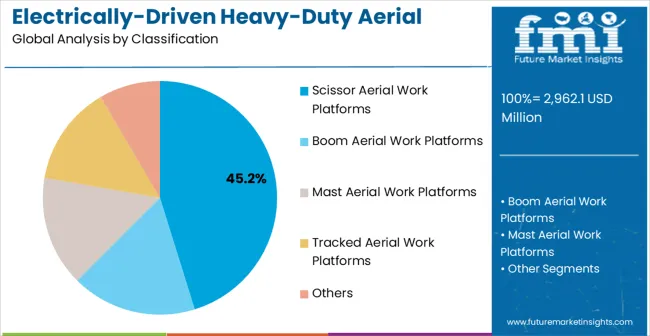
The scissor aerial work platforms segment is projected to account for 45.2% of the electrically-driven heavy-duty aerial work platforms market in 2025, reaffirming its position as the leading platform technology category. Construction equipment manufacturers and industrial maintenance providers increasingly utilize scissor platform technology for their superior stability characteristics, enhanced load capacity, and ease of operator control in heavy-duty electric lifting applications across diverse construction settings. Scissor platform technology's robust design and proven performance directly address the operational requirements for consistent vertical access and reliable load handling in electric aerial work platform operations.
This platform segment forms the foundation of modern construction equipment applications, as it represents the technology with the greatest stability potential and established compatibility across multiple construction systems. Manufacturer investments in electric drive optimization and lifting mechanism enhancement continue to strengthen adoption among construction equipment producers. With manufacturers prioritizing operational safety and equipment reliability, scissor platform systems align with both performance objectives and environmental compliance requirements, making them the central component of comprehensive electric aerial work platform strategies.
The segment benefits from continuous technological advancement in electric drive capabilities and growing availability of enhanced battery systems that enable improved lifting performance and operational efficiency at the equipment level. Additionally, construction companies are investing in sustainable lifting technologies to support project efficiency improvement and environmental compliance optimization. As construction continues to evolve and operators seek superior lifting solutions, scissor platform applications will continue to dominate the platform technology landscape while supporting equipment advancement and operational optimization strategies.
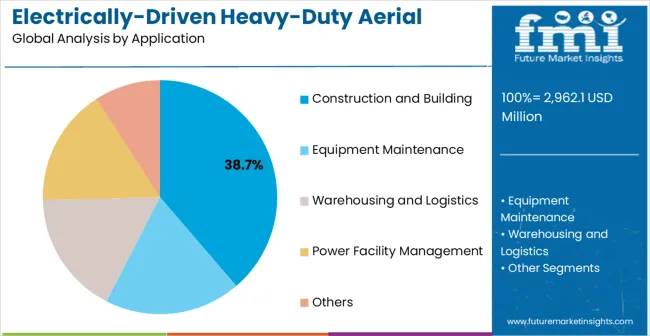
Construction and building applications are projected to represent the largest share of electrically-driven heavy-duty aerial work platforms demand in 2025 at 38.7%, underscoring their critical role as the primary application for lifting equipment in large-scale construction and building facility protocols. Equipment manufacturers and project managers prefer electric aerial work platforms for their exceptional environmental performance capabilities, emission-free operation features, and ability to maintain operational flexibility while supporting diverse construction requirements during building and infrastructure development operations. Positioned as essential equipment for sustainable construction practices, electric aerial work platforms offer both lifting performance and environmental advantages.
The segment is supported by continuous growth in sustainable construction protocols and the growing availability of advanced electric platform technologies that enable enhanced project outcomes and efficiency optimization at the construction site level. Additionally, building systems are investing in environmentally friendly construction technologies to support project sustainability improvement and operational cost optimization. As construction continues to evolve and providers seek superior lifting solutions, construction and building applications will continue to dominate the application landscape while supporting technology advancement and sustainability optimization strategies.
The construction and building segment particularly benefits from the balance between operational requirements and environmental considerations that characterize modern construction operations. This application represents an optimal point for electric platforms, where the emission-free demands are critical for indoor construction while the operational benefits compared to diesel-powered systems remain significant. The segment's growth is further supported by the increasing number of green building projects and sustainable construction initiatives that prefer the environmental performance and lower operational costs of electric lifting systems for their construction needs.
The electrically-driven heavy-duty aerial work platforms market is advancing steadily due to increasing construction sustainability demand and growing need for emission-free lifting solutions that emphasize superior environmental performance across large-scale construction and industrial maintenance applications. However, the market faces challenges, including higher initial equipment costs, battery performance limitations in extreme conditions, and charging infrastructure requirements for fleet operations. Innovation in battery technology enhancement and charging system improvement continues to influence market development and expansion patterns.
The growing adoption of electrically-driven aerial work platforms in comprehensive construction and industrial maintenance applications is enabling equipment manufacturers to develop protocols that provide distinctive environmental performance capabilities while commanding competitive positioning and enhanced operational efficiency characteristics. Advanced construction protocols provide superior sustainability while allowing more sophisticated project optimization across various construction categories and application segments. Construction systems are increasingly recognizing the competitive advantages of electric platform technology for comprehensive equipment development and construction sustainability market penetration.
Modern electrically-driven aerial work platform suppliers are incorporating advanced battery management systems, performance monitoring technologies, and operational optimization features to enhance lifting performance, improve operational outcomes, and meet equipment manufacturer demands for intelligent and reliable electric lifting solutions. These programs improve equipment performance while enabling new applications, including extended runtime operations and precision lifting systems. Advanced battery integration also allows suppliers to support premium market positioning and operational excellence leadership beyond traditional lifting products.
The construction industry's increasing emphasis on environmental compliance and operational cost optimization is driving significant demand for electrically-driven aerial work platforms that offer superior environmental performance while maintaining heavy-duty lifting capabilities. This trend is particularly evident in indoor construction projects, urban development sites, and environmentally sensitive areas where emissions regulations require equipment that can operate without producing harmful exhaust or excessive noise levels. The growing need for equipment that can support multiple operational scenarios and environmental requirements within the same project is creating opportunities for versatile electric platform solutions that can adapt to changing construction demands while maintaining consistent lifting performance and environmental compliance across different construction scenarios.
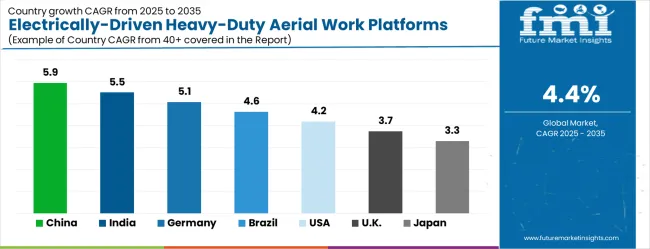
| Country | CAGR (2025-2035) |
|---|---|
| China | 5.9% |
| India | 5.5% |
| Germany | 5.1% |
| Brazil | 4.6% |
| USA | 4.2% |
| UK | 3.7% |
| Japan | 3.3% |
The electrically-driven heavy-duty aerial work platforms market is experiencing robust growth globally, with China leading at a 5.9% CAGR through 2035, driven by expanding construction infrastructure development, rising sustainable equipment adoption, and increasing focus on emission-free construction technologies. India follows at 5.5%, supported by growing infrastructure investments, expanding urban development projects, and rising focus on environmental compliance optimization. Germany shows growth at 5.1%, emphasizing sustainable construction excellence and advanced equipment development. Brazil demonstrates 4.6% growth, focusing on infrastructure development expansion and sustainable construction capabilities. The USA records 4.2%, prioritizing advanced construction technologies and comprehensive environmental solutions. The UK exhibits 3.7% growth, supported by established sustainability infrastructure and environmental equipment adoption. Japan shows 3.3% growth, focusing on precision construction technology and high-quality sustainable equipment solutions.
The report covers an in-depth analysis of 40+ countries; seven top-performing countries are highlighted below.
Revenue from electrically-driven heavy-duty aerial work platforms in China is projected to exhibit exceptional growth with a CAGR of 5.9% through 2035, driven by expanding infrastructure development projects and rising demand for sustainable construction equipment across major urban and industrial construction centers. The country's growing construction sector and increasing adoption of environmental compliance technologies are creating substantial demand for electric aerial work platform solutions in both domestic construction and export-oriented manufacturing applications. Major construction equipment manufacturers and project companies are establishing comprehensive manufacturing and technical support capabilities to serve both domestic construction needs and regional export markets.
Rising infrastructure development and expanding construction capabilities are driving demand for electrically-driven aerial work platforms across equipment manufacturers, construction facilities, and technology suppliers throughout major Chinese construction systems.
Revenue from electrically-driven heavy-duty aerial work platforms in India is expanding at a CAGR of 5.5%, supported by growing infrastructure investments, increasing urban development projects, and expanding construction infrastructure with sustainable equipment capabilities. The country's developing construction ecosystem and expanding equipment manufacturing sector are driving demand for sophisticated electric aerial work platform products across both urban construction facilities and emerging regional development centers. International equipment companies and domestic construction manufacturers are establishing comprehensive production and technical support capabilities to address growing market demand for sustainable lifting solutions.
Revenue from electrically-driven heavy-duty aerial work platforms in Germany is projected to grow at a CAGR of 5.1% through 2035, driven by sustainable construction excellence initiatives, expanding equipment development capabilities, and growing focus on environmental solutions requiring sophisticated lifting technologies. Germany's established construction infrastructure and increasing emphasis on sustainable equipment development are creating substantial demand for both standard and premium electric aerial work platform varieties. Leading equipment companies and construction specialists are establishing comprehensive technical strategies to serve both German markets and growing European equipment demand.
Revenue from electrically-driven heavy-duty aerial work platforms in Brazil is projected to grow at a CAGR of 4.6% through 2035, driven by the expansion of domestic infrastructure development, increasing urbanization initiatives, and growing construction and industrial maintenance activities. The country is focusing on building capabilities in urban construction, industrial facility development, and infrastructure modernization, creating steady demand for cost-efficient electrically-driven aerial work platforms. Global equipment manufacturers and domestic players are collaborating through partnerships and technology transfer agreements to strengthen the local ecosystem and expand access to electric platform technologies.
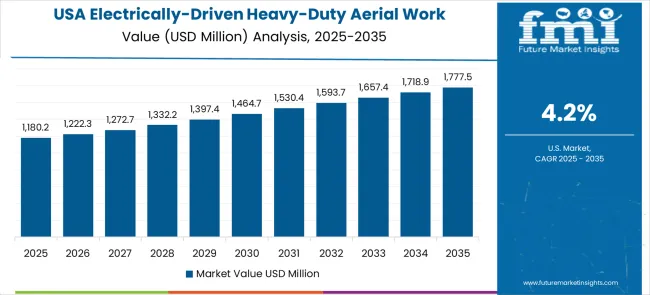
Revenue from electrically-driven heavy-duty aerial work platforms in the United States is projected to expand at a CAGR of 4.2% through 2035, supported by the country's focus on advanced construction technologies, environmental compliance infrastructure, and comprehensive sustainable solutions. Environmental regulations and sustainability initiatives drive adoption in construction projects, industrial facilities, and urban development where emission-free operation is required. Strong investments in infrastructure modernization and green building standards further encourage adoption in commercial construction, industrial maintenance, and specialized construction applications.
Revenue from electrically-driven heavy-duty aerial work platforms in the United Kingdom is expanding at a CAGR of 3.7% through 2035, driven by established environmental infrastructure, strong construction networks, and sustainable equipment adoption across construction and industrial sectors. The UK market emphasizes high-quality electric aerial work platforms for advanced construction projects, environmental compliance applications, and infrastructure development initiatives. While volume demand is smaller compared to developing markets, the UK positions itself as an environmental-focused market, integrating electric aerial work platforms into sustainable construction and specialized industrial environments.
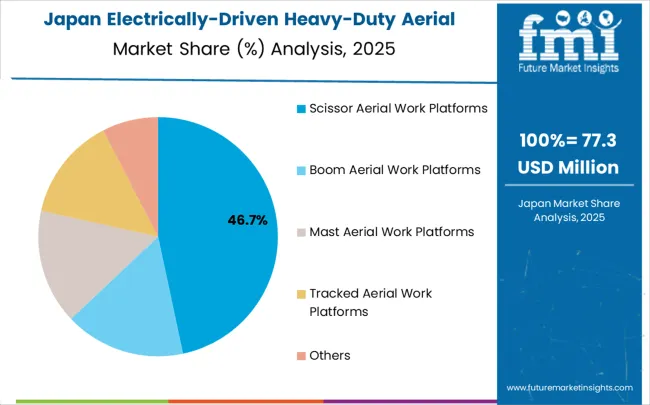
Revenue from electrically-driven heavy-duty aerial work platforms in Japan is expected to grow at a CAGR of 3.3% through 2035, reflecting the country's focus on precision construction excellence, high-quality environmental equipment, and integration of advanced sustainable solutions. Environmental regulations and precision construction standards drive adoption in specialized applications where accuracy and reliability are critical. Japan's reputation for construction excellence and technological innovation underpins continued adoption, despite slower growth relative to emerging Asian economies.
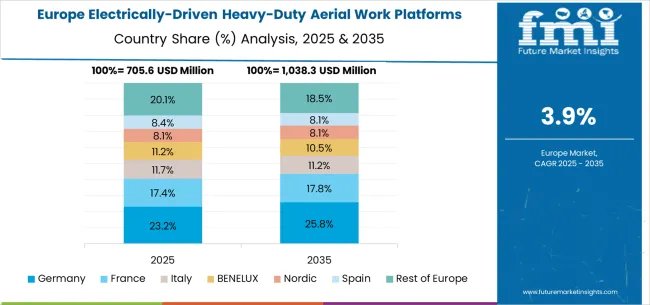
The electrically-driven heavy-duty aerial work platforms market in Europe is projected to grow at a CAGR of 4.2% from 2025 to 2035. Germany is expected to maintain its leadership position with a 28.4% market share in 2025, declining slightly to 28.1% by 2035, supported by its sustainable construction sector, advanced equipment development infrastructure, and technical capabilities serving regional and international markets.
The United Kingdom follows with a 19.2% share in 2025, projected to reach 18.9% by 2035, driven by priorities in sustainable construction, environmental excellence, and advanced equipment development. France holds a 17.1% share in 2025, expected to maintain 16.8% by 2035, supported by equipment technology integration and construction adoption, though facing challenges from competition and regulatory dynamics.
Italy accounts for 13.5% in 2025, projected to ease to 13.2% by 2035, while Spain contributes 9.8% in 2025, declining slightly to 9.6% by 2035. The Nordic Countries represent 7.8% in 2025, shifting marginally to 7.7% in 2035, while BENELUX holds 6.7% by 2035. The Rest of Western Europe region is expected to account for 4.2% in 2025, moderating to 4.1% by 2035, reflecting mixed growth dynamics across smaller and mature markets.
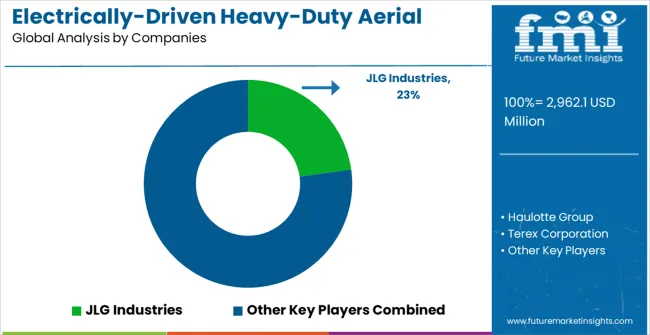
The electrically-driven heavy-duty aerial work platforms market is characterized by competition among established construction equipment companies, specialized lifting system manufacturers, and integrated technology suppliers. Companies are investing in advanced battery technologies, electric drive optimization systems, application-specific product development, and comprehensive technical support capabilities to deliver consistent, high-performance, and reliable electric aerial work platform products. Innovation in battery performance enhancement, operational efficiency extension, and customized construction compatibility is central to strengthening market position and equipment user satisfaction.
JLG Industries leads the market with a significant share, focusing on comprehensive construction equipment solutions and advanced electric technologies, offering premium electrically-driven aerial work platform products with emphasis on operational excellence and environmental performance capabilities. Haulotte Group delivers specialized lifting solutions with emphasis on equipment integration and technical reliability. Terex Corporation focuses on advanced construction solutions with emphasis on electric drive technology and operational efficiency. Skyjack specializes in aerial work platform equipment with focus on battery performance and construction reliability.
The competitive landscape is further enriched by companies like Manitou Group, which provides integrated construction solutions, and Snorkel, which focuses on comprehensive lifting equipment. Regional players including Dingli, Zoomlion Heavy Industry, Sinoboom, Niftylift, MEC Aerial Work Platforms, Cormidi, Hinowa, CTE Group, and Socage contribute to market diversity by offering specialized solutions tailored to specific regional requirements and niche applications.
| Items | Values |
|---|---|
| Quantitative Units (2025) | USD 2,962.1 million |
| Platform Type | Scissor Aerial Work Platforms, Boom Aerial Work Platforms, Mast Aerial Work Platforms, Tracked Aerial Work Platforms, Others |
| Application | Construction and Building, Equipment Maintenance, Warehousing and Logistics, Power Facility Management, Others |
| Regions Covered | North America, Europe, East Asia, South Asia & Pacific, Latin America, Middle East & Africa |
| Countries Covered | United States, Canada, United Kingdom, Germany, France, China, Japan, South Korea, India, Brazil, Australia and 40+ countries |
| Key Companies Profiled | JLG Industries, Haulotte Group, Terex Corporation, Skyjack, Manitou Group, Snorkel |
| Additional Attributes | Dollar sales by platform type and application, regional demand trends, competitive landscape, technological advancements in electric drive systems, construction integration initiatives, sustainability optimization programs, and environmental performance enhancement strategies |
The global electrically-driven heavy-duty aerial work platforms market is estimated to be valued at USD 2,962.1 million in 2025.
The market size for the electrically-driven heavy-duty aerial work platforms market is projected to reach USD 4,556.2 million by 2035.
The electrically-driven heavy-duty aerial work platforms market is expected to grow at a 4.4% CAGR between 2025 and 2035.
The key product types in electrically-driven heavy-duty aerial work platforms market are scissor aerial work platforms, boom aerial work platforms, mast aerial work platforms, tracked aerial work platforms and others.
In terms of application, construction and building segment to command 38.7% share in the electrically-driven heavy-duty aerial work platforms market in 2025.






Our Research Products

The "Full Research Suite" delivers actionable market intel, deep dives on markets or technologies, so clients act faster, cut risk, and unlock growth.

The Leaderboard benchmarks and ranks top vendors, classifying them as Established Leaders, Leading Challengers, or Disruptors & Challengers.

Locates where complements amplify value and substitutes erode it, forecasting net impact by horizon

We deliver granular, decision-grade intel: market sizing, 5-year forecasts, pricing, adoption, usage, revenue, and operational KPIs—plus competitor tracking, regulation, and value chains—across 60 countries broadly.

Spot the shifts before they hit your P&L. We track inflection points, adoption curves, pricing moves, and ecosystem plays to show where demand is heading, why it is changing, and what to do next across high-growth markets and disruptive tech

Real-time reads of user behavior. We track shifting priorities, perceptions of today’s and next-gen services, and provider experience, then pace how fast tech moves from trial to adoption, blending buyer, consumer, and channel inputs with social signals (#WhySwitch, #UX).

Partner with our analyst team to build a custom report designed around your business priorities. From analysing market trends to assessing competitors or crafting bespoke datasets, we tailor insights to your needs.
Supplier Intelligence
Discovery & Profiling
Capacity & Footprint
Performance & Risk
Compliance & Governance
Commercial Readiness
Who Supplies Whom
Scorecards & Shortlists
Playbooks & Docs
Category Intelligence
Definition & Scope
Demand & Use Cases
Cost Drivers
Market Structure
Supply Chain Map
Trade & Policy
Operating Norms
Deliverables
Buyer Intelligence
Account Basics
Spend & Scope
Procurement Model
Vendor Requirements
Terms & Policies
Entry Strategy
Pain Points & Triggers
Outputs
Pricing Analysis
Benchmarks
Trends
Should-Cost
Indexation
Landed Cost
Commercial Terms
Deliverables
Brand Analysis
Positioning & Value Prop
Share & Presence
Customer Evidence
Go-to-Market
Digital & Reputation
Compliance & Trust
KPIs & Gaps
Outputs
Full Research Suite comprises of:
Market outlook & trends analysis
Interviews & case studies
Strategic recommendations
Vendor profiles & capabilities analysis
5-year forecasts
8 regions and 60+ country-level data splits
Market segment data splits
12 months of continuous data updates
DELIVERED AS:
PDF EXCEL ONLINE
Sales Platforms Software Market Size and Share Forecast Outlook 2025 to 2035
Battery Platforms Market Analysis Size and Share Forecast Outlook 2025 to 2035
Smart City Platforms Market Size and Share Forecast Outlook 2025 to 2035
Smart Home Platforms Market Growth – Trends & Forecast through 2034
IP Centrex Platforms Market
AI Security Platforms Market Size and Share Forecast Outlook 2025 to 2035
Microlearning Platforms Market Size and Share Forecast Outlook 2025 to 2035
Virtual Event Platforms Market Trends - Growth & Forecast 2025 to 2035
Competitive Landscape of Virtual Event Platforms Market Share
Data Management Platforms Market Analysis and Forecast 2025 to 2035, By Type, End User, and Region
Digital Publishing Platforms Market Size and Share Forecast Outlook 2025 to 2035
Patient Engagement Platforms Market Size and Share Forecast Outlook 2025 to 2035
Content Experience Platforms Market Size and Share Forecast Outlook 2025 to 2035
B2B Services Review Platforms Market Size and Share Forecast Outlook 2025 to 2035
Customer Experience Platforms Market by Interaction Points, Deployment, Enterprise Size, Region-Forecast through 2035
Fixed Business Voice Platforms And Services Market Size and Share Forecast Outlook 2025 to 2035
AGV Dispatch Management Platforms Market Size and Share Forecast Outlook 2025 to 2035
Experience Optimization Platforms Market Size and Share Forecast Outlook 2025 to 2035
Mixed Reality Navigation Platforms Market Forecast and Outlook 2025 to 2035
Cloud API And Management Platforms And Middleware Market Size and Share Forecast Outlook 2025 to 2035

Thank you!
You will receive an email from our Business Development Manager. Please be sure to check your SPAM/JUNK folder too.
Chat With
MaRIA